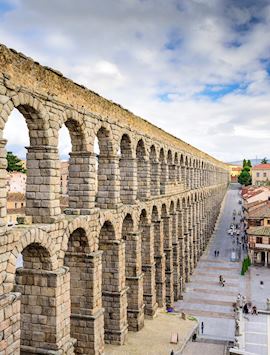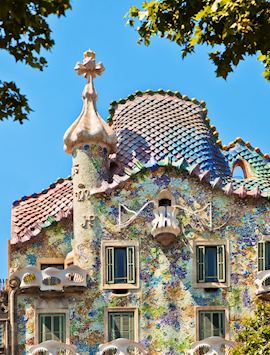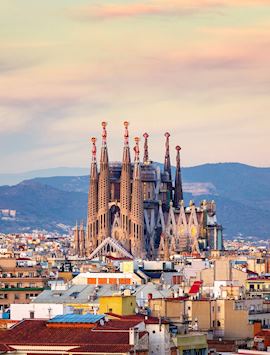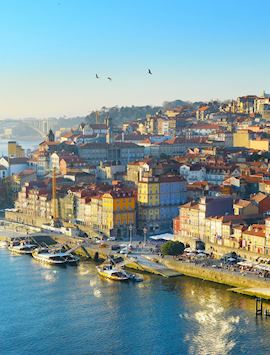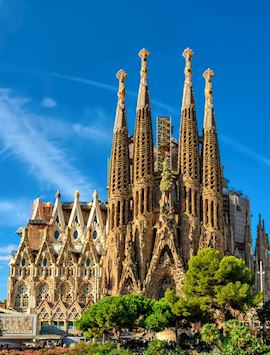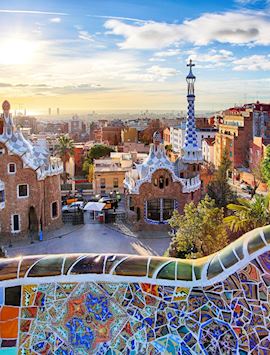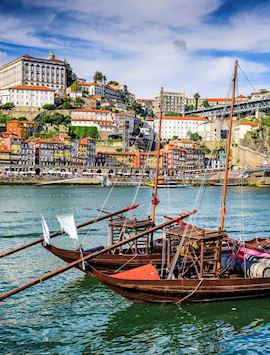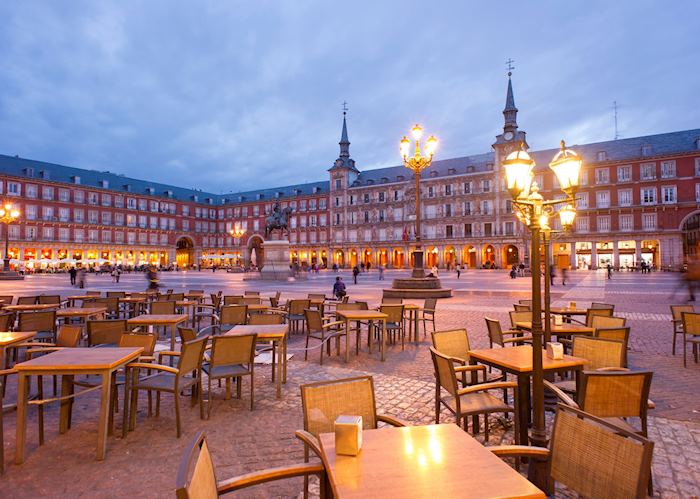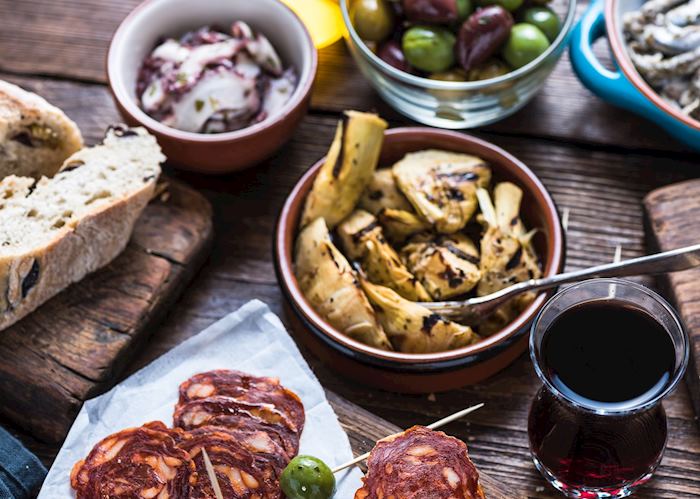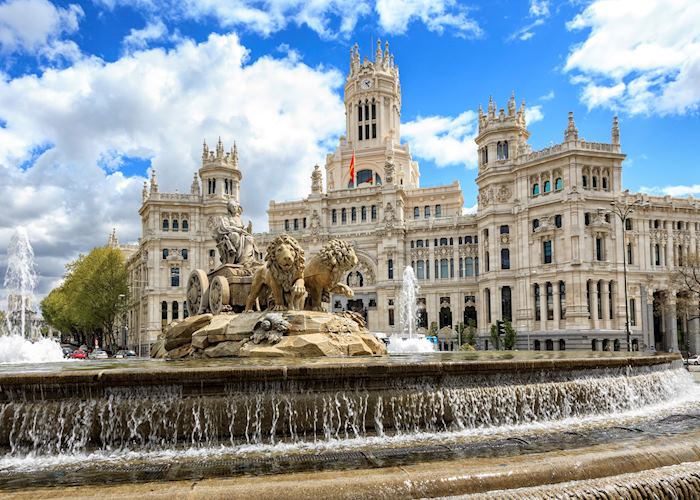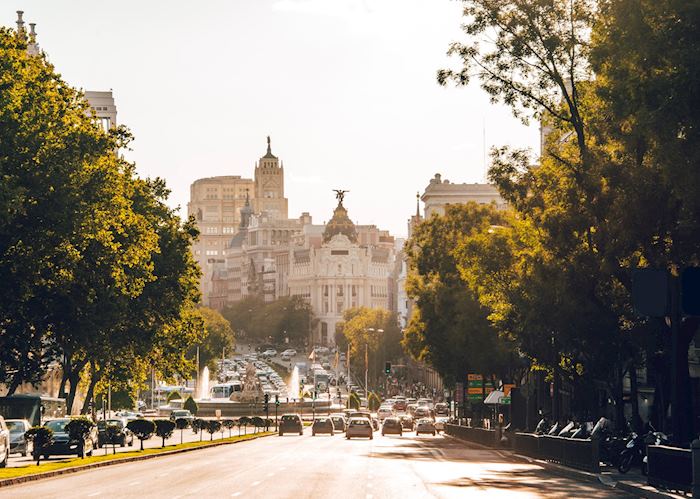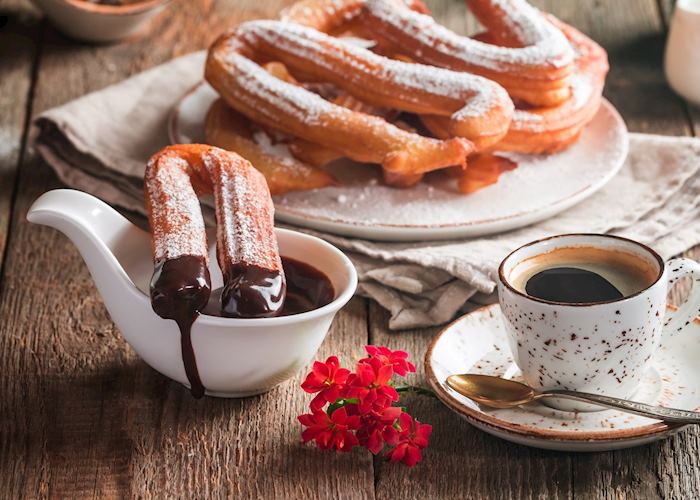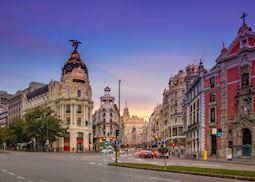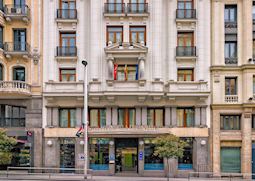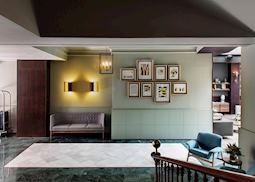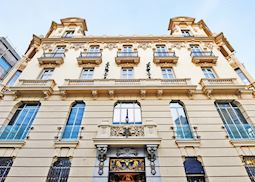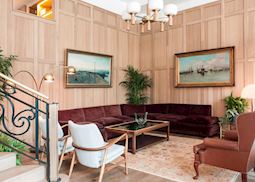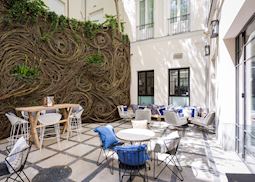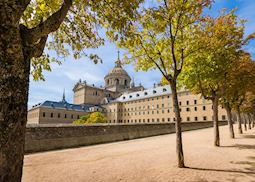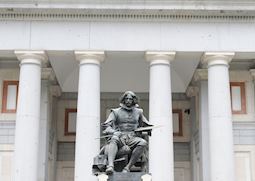Jump to:
Madrid might not have the equivalent of an Eiffel Tower or Big Ben, but, with some of the world’s best art museums, Baroque architecture and Belle Époque palaces, it doesn’t need to. As well as telling the story of Spain’s complex history, Madrid is also a modern metropolis of innovative cuisine and boutique shops.
The city wasn’t always as commanding as it is today. In the 9th century, it was a fort city built by the Moors to protect their empire’s borders, and it remained unremarkable for centuries. It wasn’t until 1561, when King Felipe II declared Madrid as Spain’s new capital, and moved his palace to nearby El Escorial, that things changed.
Each new monarch continued to develop the city and invest in public projects, including the Real Jardín Botánico (royal botanical garden), the Palacio Real and Museo Nacional del Prado. These feats still exist in their original glory, and tucked beside them you’ll find tapas restaurants and courtyards where Madrileños gather with family and friends.
Spain & Portugal specialist AllanI love Madrid’s street scene — its sleepy plazas where the locals share tapas and enjoy a cold beer or glass of wine at the end of the day. Not to mention its world-class art museums.
Things to see and do in Madrid
Golden triangle of art museums
Art flourished under the Spanish monarchy, who supported home-grown talent such as court painters Francisco de Goya and Diego Velázquez. From 1483, Spain also controlled Flanders, the capital of North European art, and Naples, home to the revolutionary Naturalism movement. Thousands of pieces were brought back to Madrid, creating one of the largest collections of art in Europe.
Known as the ‘golden triangle of art’, a trio of art museums occupy the Paseo del Prado, a tree-lined boulevard in central Madrid. You’ll need at least a day to get a brief overview, or take a guided tour for a more in-depth experience.
Museo Nacional del Prado
Opened to the public in 1819 to showcase work collected by the Spanish monarchy, the Prado’s collection reflects Spain’s history from 16th-century Flemish influences to the arrival of the Bourbons at the start of the 1700s.
The museum’s frontage is a neoclassical design of pillars and cornices. Inside the galleries, the walls and domed ceilings are painted pale taupe or cream, allowing the artwork to step forward.
Predominately a collection of paintings and sculptures, this isn’t a comprehensive assembly of Spanish art. Instead, it shows the whims of Spanish monarchs who focused on collecting as many paintings as they could of their preferred artists. This has resulted in the largest collections of paintings by El Greco, Goya and Rubens in the world. Their flair for using a rich palette can be seen in later artists’ works as the royal esthetic preferences begin to influence the development of Spanish painting.
One of the most well-known paintings is Velázquez's Las Meninas, a portrait of Infanta Margarita Teresa, who would one day be crowned the Archduchess consort of Austria, and Queen consort of Hungary and Bohemia. This is no ordinary royal portrait as Velázquez has painted himself, as well as a gaggle of regal characters, ladies in waiting and chambermaids into the composition.
Once you’ve walked through the halls of portraits, religious dioramas and mythological works, you can visit the museum’s library — the most important art library in Spain. Daily talks, tours and temporary focused exhibitions air some of the works from storage.
Museo Nacional Centro de Arte Reina Sofía
Holding a mission statement to become the contemporary museum of Spain, the Museo Nacional Centro de Arte Reina Sofía opened by royal decree in 1990. It’s housed in two buildings: a 16th-century hospital that has been updated with two glass elevator towers, and an angular modern block topped with a red patent roof that seems to hover like a spaceship coming in to land.
The museum’s collection comprises more than 21,000 works of modern and contemporary art, from the first modernists of the 19th century to artists working today.
With a continuously growing archive, only about 5% of the collection is on display at any one time. Spanish artists are the focus, with Miró, Dalí and Picasso topping the bill. Picasso’s Guernica (a reaction in monochrome oils against the Nazi bombing of Guernica) is the museum’s calling card. Home-grown artists are given international context alongside their global contemporaries, including Magritte and Klein.
Thyssen-Bornemisza Museum
Diagonally opposite the Prado is Villahermosa Palace, a neoclassical brick building that has been remodeled to house the Thyssen-Bornemisza Museum. While the Prado and Sofía concentrate on the classical and the contemporary respectively, the Thyssen’s broader collection ranges from 13th- to 20th-century works — although has become best known for its Impressionist collection. Walking around the collection is an all-encompassing journey from Benedictine abbey frescoes to abstract Rothko canvasses.
Put together as a private collection, the works were originally collated by Baron Heinrich Thyssen-Bornemisza. By the 1980s, his collection had far outstripped the family gallery by Lake Lugano in his native Switzerland, and the Spanish government stepped in to house it on permanent loan while also creating a temporary exhibition space. You can view the museum on a tour.
Real Jardín Botánico de Madrid
Opposite the Prado, a set of marble arches leads into Madrid’s botanical garden. It’s neatly laid out in a grid, each square bed focused on a particular part of the world — there’s a particular emphasis on South American flora — or type of plant, from medicinal leaves to vegetables.
The garden is ornamented with statues, fountains and domed greenhouses, but this isn’t a pleasure ground. Carlos III wanted the garden, which was founded by Ferdinando VI in 1755, to become a complex dedicated to natural science. He commissioned the largest herbarium in Spain and an on-site library to hold more than 2,000 works and reference drawings.
Specimens also include a collection of plants brought back by Spanish expeditions in the 18th century, rare orchids and bonsai trees.
El Retiro
On warm days, Madrileños (Madrid’s residents) gather from across the city to laze on El Retiro’s lawns, paddle a boat across its artificial lake or share a cool drink on one of the terrazas (terraces) across the park. It’s all a long way from El Retiro’s original purpose as a private retreat for 17th-century Felipe IV and his courtiers.
The focal point of Madrid’s largest green space is a semi-circle of great columns that curve around a bronze and marble monument to Alfonso XII, who’s astride his horse and guarded by mermaids and lions.
Spend time strolling along the boulevards and you’ll encounter gardens-within-gardens, from La Rosaleda’s fairytale roses to the Jardines de Cecilio Rodríguez, where peacocks dart between the topiary.
Palacio Real (Royal Palace)
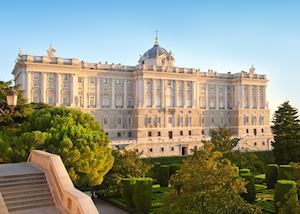 At almost twice the size of Buckingham Palace or Versailles, the Palacio Real sits proudly among trimmed gardens, ornamental ponds and plazas. A seat of royalty since the emir Muhammad I built a castle here in the 9th century, the palace in its current guise is a legacy of Felipe V, who commissioned it after the original building burned down in 1734.
At almost twice the size of Buckingham Palace or Versailles, the Palacio Real sits proudly among trimmed gardens, ornamental ponds and plazas. A seat of royalty since the emir Muhammad I built a castle here in the 9th century, the palace in its current guise is a legacy of Felipe V, who commissioned it after the original building burned down in 1734.
It’s no longer the official residence of the King of Spain (who prefers to live on the outskirts of the city in Zarzuela Palace), but it’s still used occasionally for official state functions. You can visit a fraction of the 3,418 rooms, including the Throne Room with its lavish gold and red Rococo carpet and matching walls, and gilded furniture so polished it seems to glow.
Carlos III’s bedroom is also open to visitors. Its hulking mahogany furniture was designed by Sabatini, one of the palace’s main architects. As you walk through the palace, you can see parts of the royal art collection in situ, as well as grand ensembles of porcelain and watches, and a Stradivarius string quintet.
Best time to visit Madrid
Visit from September to November or March to May and you should enjoy dry, warm days that average around 59°F (15°C). If you don’t mind cooler temperatures and the occasional shower, in winter (December to February) the sites are quieter and hotels reduce their rates. Despite high temperatures, July and August can be very busy and some restaurants and shops close as Madrileños leave the city to holiday.
who's been there
-
617-223-4521617-223-4767
- Make an inquiry
Suggested itineraries featuring Madrid
Our itineraries will give you suggestions for what is possible when you travel in Madrid, and they showcase routes we know work particularly well. Treat them as inspiration, because your trip will be created uniquely by one of our specialists.
Places near Madrid
- El Escorial & Valle de los Caídos 25 miles away
- Toledo 43 miles away
- Segovia 43 miles away
- Ávila 55 miles away
- Salamanca 110 miles away
- La Rioja 155 miles away
- Córdoba 185 miles away
- Bilbao 201 miles away
- The Basque Country and La Rioja 203 miles away
- San Sebastián 220 miles away
- Granada 224 miles away
- Asturias 231 miles away
- Oviedo 232 miles away
- Seville 243 miles away
- Andalusia 243 miles away
- Costa del Sol 260 miles away
- Ronda 266 miles away
- Galicia 272 miles away
- Catalonia 285 miles away
- Cava wine region 288 miles away
- Pontevedra 292 miles away
- Ibiza 293 miles away
Photos of Madrid
Our expert guides to exploring Madrid
Written by our specialists from their own experiences of visiting Madrid, these guides will help you make the most of your time there. We share both our practical recommendations and the best ways to appreciate Madrid at its best.
-
In and around Madrid: our highlights guide ![Gran Vía, Madrid]()
In and around Madrid: our highlights guide
In and around Madrid: our highlights guide
Gritty and gracious, Madrid boasts a lively street life, a trio of world-class museums and the largest palace in Western Europe. It’s also a good base for exploring some of Spain’s small medieval cities like Toledo, Ávila and Segovia.
Read this guide
Accommodation choices for Madrid
We've selected a range of accommodation options for when you visit Madrid. Our choices usually come recommended for their character, facilities and service or location. Our specialists always aim to suggest properties that match your preferences.
-
![H10 Villa de la Reina, Madrid]()
H10 Villa de la Reina
Madrid -
![Tótem Madrid, Madrid]()
Tótem Madrid
Madrid -
![Catalonia Las Cortes, Madrid]()
Catalonia las Cortes
Madrid -
![URSO Hotel & Spa, Madrid]()
URSO Hotel and Spa
Madrid -
![NH Collection Madrid Suecia, Madrid]()
NH Collection Madrid Suecia
Madrid -
![Only YOU Hotel, Madrid]()
Only YOU Boutique Hotel
Madrid
Ideas for experiencing Madrid
Our specialists seek out authentic ways to get to know the places that could feature in your trip. These activities reflect some of the experiences they've most enjoyed while visiting Madrid, and which use the best local guides.
-
El Escorial and Valley of the Fallen ![Monastery, El Escorial]()
El Escorial and Valley of the Fallen
El Escorial and Valley of the Fallen
You can explore two very different periods in Spain’s history on this half-day tour from Madrid that takes in the monastery-palace of El Escorial as well as the poignant civil war memorial the Valley of the Fallen.
View details -
Ávila and Segovia ![Roman aqueduct, Segovia]()
Ávila and Segovia
Ávila and Segovia
You’ll visit two of the historic cities of Castilla y León — UNESCO World Heritage Sites Ávila and Segovia — on this full-day tour. You’ll stroll their winding streets and see their monumental medieval fortifications, palaces and cathedrals, and Segovia’s Roman aqueduct.
View details -
Museo del Prado and Centro de Arte Reina Sofía ![Museo del Prado, Madrid]()
Museo del Prado and Centro de Arte Reina Sofía
Museo del Prado and Centro de Arte Reina Sofía
You can explore the vast collections at the Prado and Centro de Arte Reina Sofía in Madrid on this guided half-day tour. It offers an expert’s insight into the history of Spanish art, as well as its most prestigious museums.
View details -
Toledo visit with wine tasting ![Winery outside of Toledo, Spain]()
Toledo visit with wine tasting
Toledo visit with wine tasting
Toledo’s rich history, architectural diversity and cathedral come to life on this full-day privately guided tour to the city from Madrid. You’ll also have time to visit a local vineyard to tour the cellars and sample its wine.
View details


